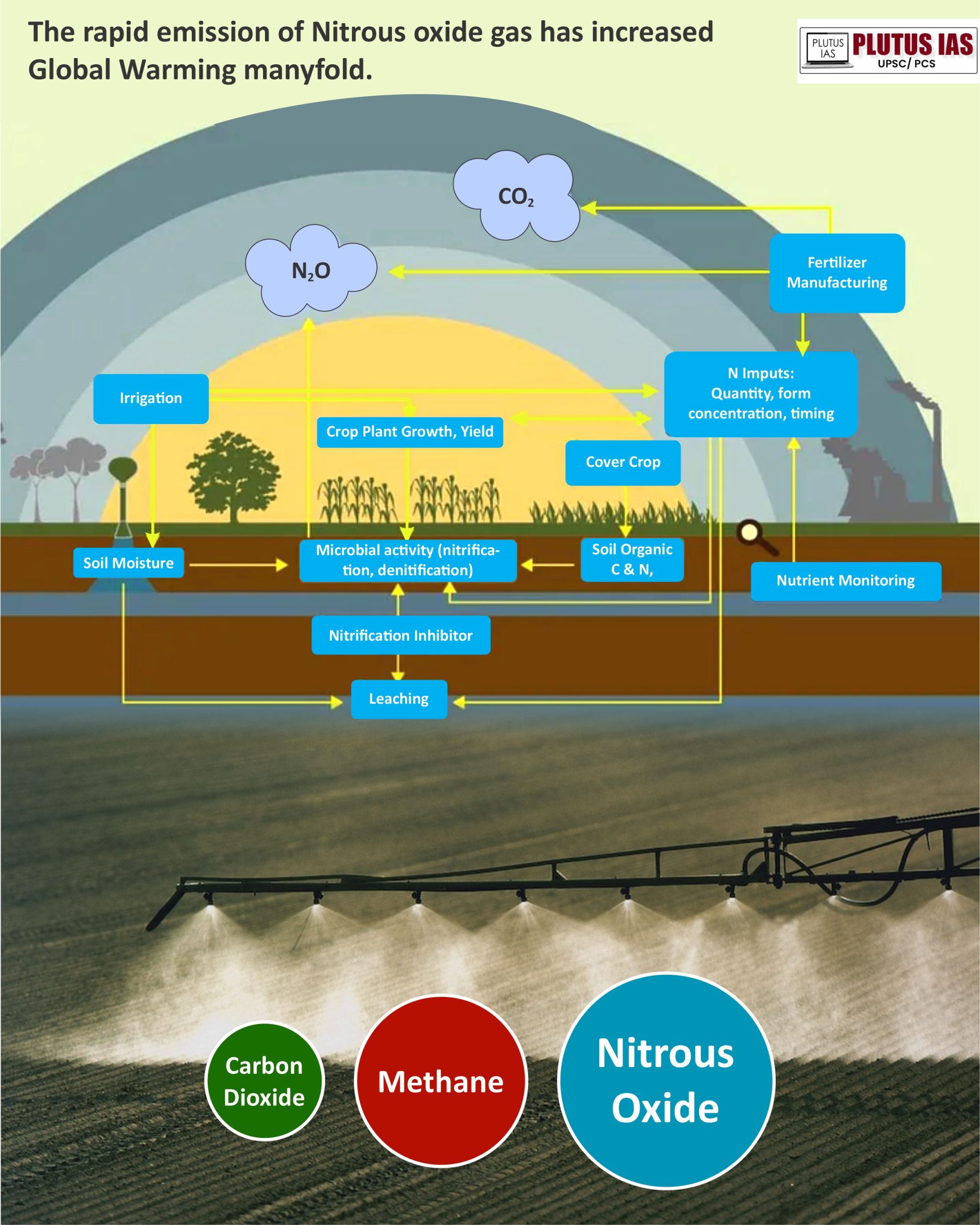13 Jun “India ranked 2nd largest Nitrous Oxide emitter after China.”
This article covers “Daily Current Affairs” and the topic details of “India ranked 2nd largest Nitrous Oxide emitter after China.”. This topic is relevant in the “Environment and Ecology” section of the UPSC- CSE Exam.
Why in the news?
India ranks as the world’s second-largest contributor to nitrous oxide (N2O), a greenhouse gas with a significantly higher heat-trapping capacity compared to carbon dioxide. In 2020, approximately 11% of the world’s human-induced N2O emissions originated from India, placing it behind China, which accounted for 16%. The primary driver of these emissions is attributed to fertiliser application, as highlighted in a comprehensive global evaluation of N2O emissions featured in the journal Earth System Science Data.
Highlights of Reports?
- In 2022, atmospheric levels of N2O surged to approximately 25% higher than pre-industrial levels.
- In contrast, carbon dioxide concentrations reached 417 parts per million during the same period, indicating that CO2 levels are a thousand times greater than those of nitrous oxide. Consequently, countries prioritising climate action have focused predominantly on reducing carbon dioxide emissions.
- However, due to its prolonged atmospheric presence and escalating rates, scientists have emphasised the urgent need to address nitrous oxide emissions.
- Over the past four decades, human-induced N2O emissions have surged by 40%, equivalent to an increase of three million metric tonnes annually.
- The growth rates observed between 2020 and 2022 surpass any recorded period since 1980, when reliable measurements began. Notably, agricultural activities utilising nitrogen-based fertilisers and animal manure have contributed 74% of anthropogenic N2O emissions in the last decade alone.
- N2O emissions, responsible for 6.4% of the effective radiative forcing of greenhouse gases, have exacerbated global warming by approximately 0.1 degrees Celsius.
- The latest assessment of the nitrous oxide budget underscores the urgency of the situation. It signals a critical moment for India to heed this warning and implement substantial changes in cropping systems and production practices.
About Nitrous Oxide:
- Nitrous oxide(N2O), commonly known as laughing gas, is a colourless gas, slightly sweet odour and taste. When inhaled, it produces a brief euphoric effect and can be used as a recreational drug.
- With a potency 300 times greater than carbon dioxide (CO2), nitrous oxide (N2O) stands as a formidable greenhouse gas (GHG) contributing significantly to global warming.
- Ranking third in atmospheric concentration among GHGs, following CO2 and methane (CH4), N2O poses a substantial threat to Earth’s climate stability. Moreover, it represents the sole remaining peril to the ozone (O3) layer, persisting in the atmosphere for extensive periods akin to CO2.
- Its longevity extends up to 125 years, highlighting the critical need for mitigation efforts to curb its detrimental impact on both climate and ozone layer health.

Sources of nitrous oxide (N2O) emissions are:
- Agriculture: This sector accounts for the largest share of N2O emissions, primarily due to the use of artificial nitrogen fertilizers in crop production. Nitrogen fertilisation of agricultural soils and management of animal waste are significant contributors to agricultural emissions.
- Energy Use: Nitrous oxide emissions from energy sources include those from mobile sources, such as passenger cars and light trucks, as well as stationary sources like coal combustion at electric power plants.
- Industrial Processes: Industrial processes, particularly the production of adipic acid and nitric acid, are significant sources of N2O emissions. The oxidation process involved in these productions releases nitrous oxide emissions.
- Waste Management: Waste management processes, including the treatment of residential and commercial wastewater, also contribute to N2O emissions.
- Natural Sources: Natural sources, such as marine and tropical forests, continue to account for a significant portion of N2O emissions, although their share has decreased over time.
Way forward:
- Improved Agricultural Practices: Enhance nitrogen management in agriculture by promoting precision farming techniques, optimal fertiliser application, and efficient irrigation methods to minimise nitrogen runoff and leaching, thereby reducing N2O emissions from fertilised soils.
- Utilisation of Nitrogen-Fixing Crops: Encourage the cultivation of leguminous crops and other nitrogen-fixing plants that naturally nitrogen enriched the soil with, reducing the need for synthetic nitrogen fertilisers and subsequently lowering N2O emissions.
- Integrated Crop-Livestock Systems: Implement integrated farming systems where animal waste is recycled as organic fertiliser, reducing the dependency on synthetic fertilisers and mitigating N2O emissions from manure management.
- Innovative Fertilizer Technologies: Promote the adoption of advanced fertiliser formulations, such as slow-release and nitrification inhibitors, to optimise nutrient uptake by crops and minimise nitrogen losses to the atmosphere as N2O.
- Afforestation and Agroforestry: Expand afforestation efforts and integrate agroforestry practices into agricultural landscapes to sequester carbon in soils and vegetation, which can indirectly mitigate N2O emissions by improving soil health and reducing nitrogen inputs.
- Education and Awareness: Increase awareness among farmers, policymakers, and the public about the environmental impacts of nitrous oxide emissions and the importance of adopting sustainable agricultural practices such as cropping patterns and the use of biofertilisers to mitigate climate change and protect the ozone layer.
- Policy Interventions and Incentives: Implement regulatory measures, such as emissions standards and carbon pricing, to incentivise emission reductions and promote the adoption of low-emission agricultural practices. Additionally, provides financial incentives, subsidies, and technical support to farmers transitioning to sustainable farming methods.
- Research and Innovation: Invest in research and development initiatives to advance technologies for measuring, monitoring, and reducing nitrous oxide emissions from agricultural activities. Foster collaboration between scientists, policymakers, and stakeholders to develop effective mitigation strategies tailored to regional and local contexts.
Download plutus ias current affairs eng med 13th June 2024
Prelims based Question:
Q. World`s largest Nitrous Oxide(N2O) emitter is:
A. EU
B. China
C. India
D. Bangladesh
Answer: B
Mains based Question:
Q. “The world must focus not only on carbon dioxide gas but also on the top three greenhouse gases (GHG) emitting gas contributing to the Global Warming.”Discuss.



No Comments